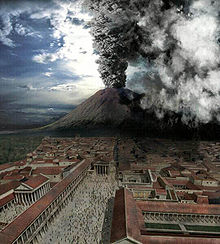
Photo – Pompeii, the Last Days SOURCE Wikipedia Public Domain
from Popular Archaeology
Sat, May 12, 2012
In 1980, people began to take notice when workers from a commercial logging company began dredging up pottery fragments and bones in an area near the little village of Pancasila on the island of Sumbawa, Indonesia. Other locals began finding coins, brassware and charred timber in the same region, all buried beneath a thick layer of volcanic deposits. The finds were not far from the foot of the Tambora volcano, a volcano that, in April of 1815, produced the largest eruption in recorded history. In fact, so intense was the eruption, it’s atmospheric effects influenced weather patterns across faraway Europe and North America. And in one evening alone, it destroyed at least one entire village kingdom near its feet.
Acting on the discovery of these finds in 2004, Volcanologist Haraldur Sigurdsson of the University of Rhode Island began investigating the jungle-shrouded area by using Ground Penetrating Radar. He identified a complete house buried under 2-3 metres of pyroclastic flow and surge deposits. . . . Read Complete Report







Leave a Reply